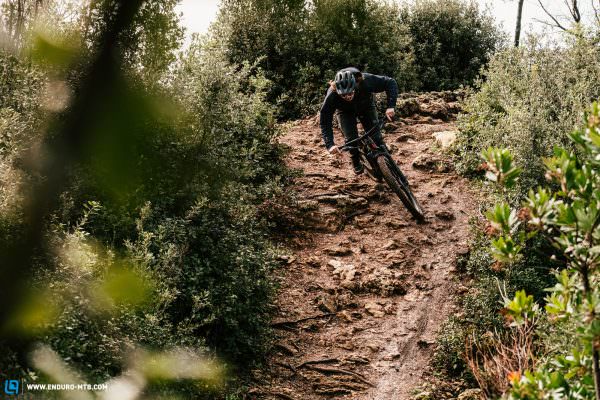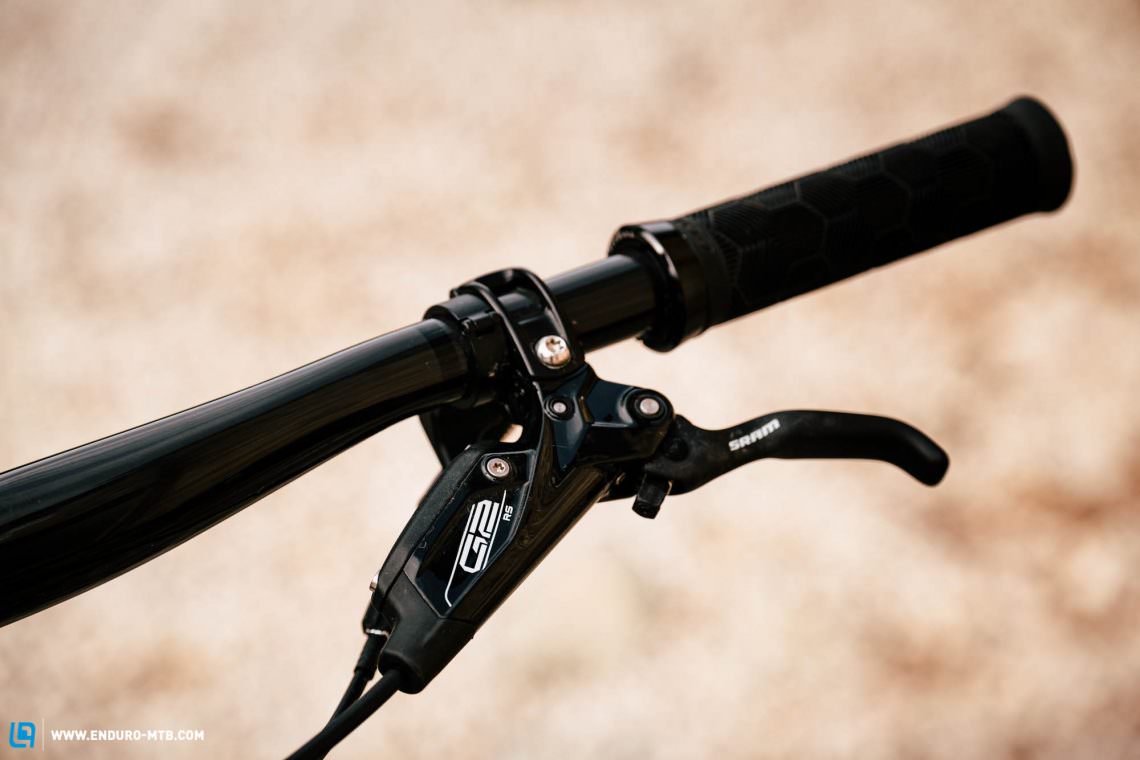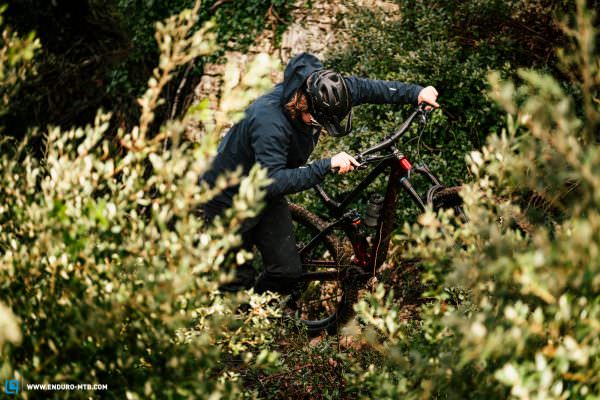The Trek Fuel EX has proven itself as an excellent all-rounder in the past. This year, the American brand enters the race with the € 5,999 Trek Fuel EX 9.8 GX, which combines a high-end frame with a mid-level spec but still features Trek’s own Thru Shaft shock technology. So does it always have to be top-spec? How big is the difference in performance and how does the Fuel EX 9.8 GX fare against its more expensive peers?
For an overview of the test fleet head to the group test: The best mountainbike of 2021 – 22 models in review

13.48 kg (size L) | € 5,999 | Manufacturer-website
The Trek Fuel EX 9.8 GX features an elegant carbon frame and makes a very high-quality impression with its semi-translucent red finish with visible carbon fibres. It has 140 mm travel at the front and 130 mm at the rear and comes equipped with a Thru Shaft technology shock, developed specially by RockShox for Trek. The shock uses fewer seals, which is claimed to reduce friction and improve sensitivity. Trek’s proprietary internal storage compartment in the down tube offers enough room to stow a spare inner tube, a CO2 cartridge and a few trail snacks. A long TPU down tube guard protects the carbon frame from impacts and stray rocks. The chainstay protector prevents chain slap and ensures a quiet ride, making the Trek one of the quietest bikes in the test. The integrated Knock Block limits the steering angle and thus prevents the fork crown from damaging the frame or cables from tearing off. You never hit that limit on the trail but it could pose some issues when transporting the bike.


The spec of the Trek Fuel EX proves that affordable bikes can deliver
For this test, Trek didn’t send us the top-of-the-range model we requested but the more affordable Fuel EX 9.8 GX model. This retails at € 5,999 and comes equipped with a 140 mm FOX 36 Performance fork, which uses the worse-performing FIT4 damper rather than the top-end GRIP2 cartridge but still keeps up with the FIT4 forks on the trail. At the rear, a FOX Performance Float Thru Shaft shock controls 130 mm travel. The 12-speed SRAM GX drivetrain with a 10–52 cassette delivers the same gear range and shifting performance as SRAM’s more expensive offerings and only weighs a few grams more. Braking is taken care of by SRAM G2 RS brakes, paired with a 200 mm rotor at the front and a smaller 180 mm disc at the rear: unfortunately, the latter doesn’t do justice to the potential of the Fuel EX, requiring strong fingers and tending to overheat on long descents.

For all other components, Trek rely on in-house Bontrager components. That includes a 170 mm Line Elite dropper post and 780 mm carbon bars. The in-house Line Elite 30 carbon wheelset rolls on wide, puncture-prone 2.6” Bontrager XR4 Team Issue tires. Ironically, the “Issue” designation is rather fitting. To avoid pinch flats and, in the worst case, irreversible damage to the carbon rims, you’ll have to run very high air pressures which only exacerbates the limited grip of the low-profile tread. Add to that the hard compound and the XR4 generates too little traction. We recommend upgrading the standard tires to a narrower 2.4″ or 2.5” model with a more robust casing.The Trek Fuel EX 9.8 GX in size L hits the scales at 13.5 kg.
Uphill, the Fuel EX generates lots of traction and offers a high level of comfort, delivering an impressive performance in all imaginable uphill situations.

The cleverly integrated storage compartment offers enough space for snacks and tools and everything is neatly packed in a bag. This prevents your items from disappearing into the depths of your frame.

Unfortunately, the standard Bontrager XR4 tires generate little traction and only offer undefined handling – we’re not convinced. That’s a shame because a good set of tires would unlock the full potential of the bike.

The Knock Block in the headset prevents the fork from damaging the frame and cables from tearing off.
Trek Fuel EX 9.8 GX
€ 5,999
Specifications
Fork FOX 36 Elite 140 mm
Rear Shock FOX DPS Elite EVOL 130 mm
Seatpost Bontrager Line Elite 170 mm
Brakes SRAM G2 RS 200/180 mm
Drivetrain SRAM GX Eagle 1x12
Stem Bontrager Line Pro (35) 45 mm
Handlebar Bontrager Line Pro OCVL 780 mm
Wheelset Bontrager Line Elite 30 29"
Tires Bontrager XR4 Team Issue 2.6
Technical Data
Size XS S M M/L L XL
Weight 13.48 kg

Sounds complicated but it’s not. The shock was specially developed for Trek and is supposed to deliver less friction and a more sensitive response.

The FOX 36 Performance Elite fork also offers high performance. While it can’t keep up with its high-end GRIP2 counterpart, it performs better than the FIT4 models in our test.

The standard SRAM G2 RS brakes require strong fingers and tend to overheat due to the small 180 mm rear rotor.
The geometry of the Trek Fuel EX 9.8 GX in detail
The Fuel EX is available in six sizes from XS to XL. For the smallest XS and S frames, Trek have adapted the shape of the top tube to give short riders more freedom of movement. In addition, the smallest XS frame is only available with 27.5” wheels, while the size S is available with both 29” and 27.5” wheels. All other frames roll on big 29” wheels. The intermediate M/L is a real highlight, providing many riders the choice of at least two suitable frames. The reach of our Fuel EX test bike (size L) is 470 mm. Chainstays are 437 mm across all sizes and the geometry of the Fuel EX can be adjusted via a flip-chip in the rocker. We recommend the low setting, which slackens the head angle by 0.5° – this is the setting we used the most in this test!
| Size | XS | S | M | M/L | L | XL |
|---|---|---|---|---|---|---|
| Seat tube | 356 mm | 395 mm | 420 mm | 435 mm | 450 mm | 500 mm |
| Top tube | 546 mm | 567 mm | 577 mm | 603 mm | 634 mm | 663 mm |
| Head tube | 90 mm | 100 mm | 100 mm | 105 mm | 105 mm | 120 mm |
| Head angle | 66.0° | 66.0° | 66.0° | 66.0° | 66.0° | 66.0° |
| Seat angle | 75.0° | 75.0° | 75.0° | 75.0° | 75.0° | 75.0° |
| Chainstays | 437 mm | 436 mm | 436 mm | 437 mm | 437 mm | 437 mm |
| BB Drop | 21 mm | 21 mm | 34 mm | 34 mm | 34 mm | 34 mm |
| Wheelbase | 1,120 mm | 1,143 mm | 1,154 mm | 1,179 mm | 1,211 mm | 1,242mm |
| Reach | 408 mm | 428 mm | 440 mm | 455 mm | 470 mm | 495 mm |
| Stack | 563 mm | 572 mm | 609 mm | 613 mm | 613 mm | 627 mm |

Pants Pearl Izumi Summit AmFIB | Sjoes Ride Concepts Powerline
More comfort is almost impossible! The Trek Fuel EX 9.8 GX on the trail
As far as riding comfort goes, hardly any bike in our big 2021 group test beats the Trek Fuel EX. The pedalling position is balanced and comfortable and the suspension works efficiently. Even without the climb switch, the Fuel EX climbs willingly while the suspension tracks the ground sensitively, ensuring a high level of comfort and sufficient traction to negotiate technical uphills with ease. While it’s not as nimble as strong climbers like the Yeti SB115, the Fuel EX shines with its comfortable pedalling position, which also makes it an excellent option for long rides. Uphill, it has nothing to begrudge its little brother, the Trek Top Fuel 9.9 X01, while downhill it leaves it behind in a cloud of dust. The Fuel EX strikes a great balance between nimbleness and smoothness, inspiring sufficient confidence on steep descents thanks to its high front.
On steep, rough terrain, the bike inspires confidence and ensures a reasonably smooth ride.


Tuning-tips: narrower tires with a more aggressive tread | heavy riders should run a bigger brake rotor at the rear to unlock the full potential of the bike
On narrow trails and berms, it’s playful and agile. While the rear end lacks end-stroke progression, the suspension still provides sufficient support for active riding maneuvers, generating good traction and remaining composed even on fast and rough trail sections. As a result, the Fuel EX feels most comfortable on flowing trails and singletrack. However, when the trails get too rough and more closely resemble downhill tracks, the rear end reaches its limit – as a result, the Fuel EX struggles to keep up with more capable bikes like the Canyon Spectral. Here, the limiting factor is the rear tire, which offers little puncture protection, has a very shallow profile and has vague handling due to its large surface area. In corners and under braking, the lack of traction costs the Trek a great deal of precision.

Conclusion
Despite the affordable spec, the Trek Fuel EX 9.8 GX convinces with a high level of comfort and good traction on all sorts of climbs. Downhill, it shines with its intuitive and balanced handling on flowing trails and singletracks. The build quality is high and frame details such as the integrated storage compartment are well-thought-out. Unfortunately, the spec isn’t perfect and crucial components such as the tires and brakes limit the riding fun.
Tops
- very comfortable uphill
- intuitive handling
- high-quality frame with integrated storage compartment
Flops
- tires are very puncture prone and generate little traction
- brakes don't do the bike’s potential justice
Find more information here trekbikes.com

The testfield
Get an overview of the grouptest here: The best mountainbike of 2021 – 22 models in review
All Bikes in this group test: Canyon Neuron CF SLX 9 (Click for review) | Canyon Spectral 29 LTD (Click for review) | Canyon Stoic 4 (Click for review) | FOCUS THRON 6.9 (Click for review) | Ibis Ripmo V2 (Click for review) | MERIDA eONE-SIXTY 10K (Click for review) | MERIDA NINETY-SIX 8000 (Click for review) | Nukeproof Reactor 290C (Click for review) | Orbea Rise M-Team (Click for review) | Propain Hugene (Click for review) | RAAW Jibb XTR Build (Click for review) | Rocky Mountain Instinct C70 (Click for review) | Santa Cruz 5010 X01 (Click for review) | Santa Cruz Tallboy CC X01 (Click for review) | SCOTT Ransom 900 Tuned AXS (Click for review) | Specialized S-Works Stumpjumper (Click for review) | Specialized S-Works Stumpjumper EVO (Click for review) | Specialized S-Works Turbo Levo SL (Click for review) | Trek Fuel EX 9.8 GX | Trek Top Fuel 9.9 X01 (Click for review) | Yeti SB115 TURQ3 (Click for review) | YT IZZO BLAZE 29 (Click for review)

Did you enjoy this article? If so, we would be stoked if you decide to support us with a monthly contribution. By becoming a supporter of ENDURO, you will help secure a sustainable future for high-quality mountain bike journalism. Click here to learn more.
Words: Peter Walker Photos: various









